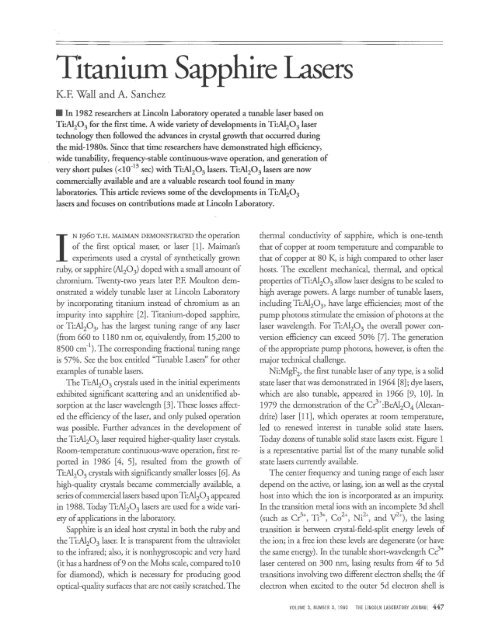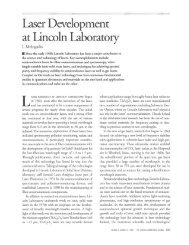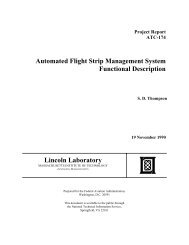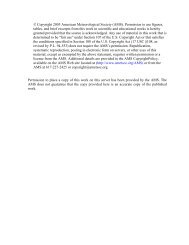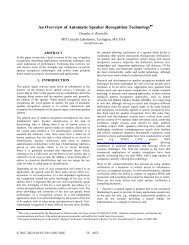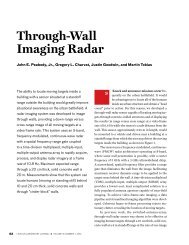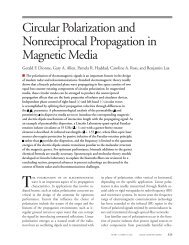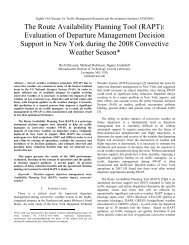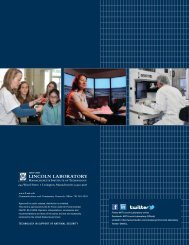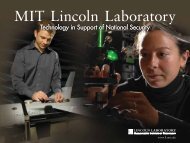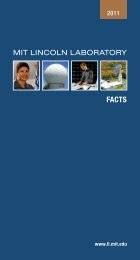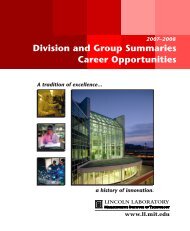TItanium Sapphire Lasers - MIT Lincoln Laboratory
TItanium Sapphire Lasers - MIT Lincoln Laboratory
TItanium Sapphire Lasers - MIT Lincoln Laboratory
Create successful ePaper yourself
Turn your PDF publications into a flip-book with our unique Google optimized e-Paper software.
<strong>TItanium</strong> <strong>Sapphire</strong> <strong>Lasers</strong><br />
K.F. Wall and A. Sanchez<br />
• In 1982 researchers at <strong>Lincoln</strong> <strong>Laboratory</strong> operated a tunable laser based on<br />
Ti:Al 2 0 3 for the first time. A wide variety ofdevelopments in Ti:Al z 0 3 1aser<br />
technology then followed the advances in crystal growth that occurred during<br />
the mid-1980s. Since that time researchers have demonstrated high efficiency,<br />
wide tunability, frequency-stable continuous-wave operation, and generation of<br />
very short pulses (
I, THl ARTICLE we refer to a tunable<br />
laser as one whose frequency can be<br />
changed in a continuous manner<br />
over a large fraction (more than 5%)<br />
ofirs central frequency. This definition<br />
eliminates lasers such as argonion,<br />
krypton-ion, and helium-neon<br />
lasers that can lase at a number of<br />
specific frequencies but are not continuously<br />
tunable from one frequency<br />
to another. arrowband<br />
continuously tunable radiation i<br />
desirable in a variety of pecrroscopic<br />
techniques uch as remore sensing,<br />
or for an agile-beam coherent laser<br />
radar system as described in chis<br />
work. A broad bandwidth i de irable<br />
for the producrion of short<br />
pulses thar have a variety of uses in<br />
spectroscopy.<br />
A variety of lasers are runable<br />
over an appreciable fraction oftheir<br />
central frequency. The most common<br />
runable lasers are the organic<br />
dye lasers. A dye laser consisrs ofan<br />
organic dye (such as a polymechine,<br />
xanthene, or coumarin dye) in a<br />
liquid solvent or ho r. A typical dye<br />
laser such as Rhodamine 6G can be<br />
runed from 570 to 610 om; other<br />
dyes have laser bandwidth thar<br />
cover portion ofthe spectrum from<br />
the ultravioler to the infrared. In a<br />
Ti:Al z0 3 laser the laser transirion is<br />
between two electronic levels of a<br />
single Ti 3 +ion and in dye lasers the<br />
laser transition is from one molecular<br />
eleCtronic level to another. The<br />
broadening of the ab orption and<br />
448 THE LINCOLN LABORATORV JOURNAL VOLUME 3. NUMBER 3 1990<br />
TU ABLE LASERS<br />
luminescence bands is caused by<br />
the multitude of rotational levels<br />
associared with each molecular<br />
eleCtronic level. Undesirable characteristics<br />
of dye lasers are toxicity<br />
of the dyes and olvents, degradation<br />
of the dyes with rime, and<br />
amplitude noise in the laser Output<br />
(because the dyes are flowed to reduce<br />
thermal loads).<br />
Another class of runable solid<br />
scate lasers are the alkali-halide colorcenter<br />
lasers. A color center i a<br />
crysral defect in which an electron<br />
becomes rrapped. For example, an<br />
F color center consisrs ofan electron<br />
rrapped at an anion vacancy ofthe<br />
cryStal lattice. The excirations ofthe<br />
napped electron uongly couple to<br />
the phonons ofthe lattice and give<br />
rise co broad absorption and emission<br />
bands. Color-center lasers can<br />
span the wavelength range from 800<br />
om, where organic dye lasers are of<br />
limired usefulness, to 4 ,um.<br />
Color-cemer lasers have many<br />
drawbacks; one is that in many alkali-halide<br />
crystals the color centers<br />
are not stable ar room temperature<br />
and will degrade on the time scale<br />
ofa day. Color-eenter lasers doped<br />
withTr (runable from 1.45 co 1.75<br />
,um and 2.3 to 3.45 .urn), which<br />
have recenrly become commercially<br />
available, have solved the rability<br />
problem [1]. Cryogenic temperatures<br />
are necessary for the stability<br />
of many color-eenter lasers, and<br />
low temperatures are necessary for<br />
efficiem operarion because rhe<br />
liferime of the upper laser level<br />
decreases according to 1/ T, where T<br />
i the remperature. In addition, since<br />
alkali-halide crystals are hygroscopic,<br />
they musr be contained in<br />
a cell.<br />
Figure 1 summarizes other examples<br />
ofrunable solid stare lasers.<br />
iZ+:MgF z was acrually the firsr<br />
runable laser of any type [2]; an<br />
analog to it (Co z +:MgFz) interesrs<br />
rhe medical community because<br />
its tuning range overlaps srrong<br />
absorprion bands in warer (of<br />
which the human body is primarily<br />
composed). Cr can be doped into<br />
a variery of marerials and in<br />
many cases form runable lasers (such<br />
as forsretire or alexandrire). Tiranium-doped<br />
chrysoberyl is a<br />
second example of a runable laser<br />
based upon 1j3+ [3]. "'oain, ir should<br />
be poimed our thar Ti:Al Z 0 3 is<br />
rhe champion in rerms of runmg<br />
range.<br />
&femues<br />
1. T.T. Basiev. .B. Mirou, and V.V.<br />
o iko, "Room-Temperarure Color<br />
Cenrer <strong>Lasers</strong>," IEEE j. Quantum<br />
ELectron. 24, 10-2 (1988).<br />
2. L.F. Johnson, R.E. Dierz, and H.J.<br />
Guggenheim, "Optical Maser 0 cillation<br />
from 'i 2 • in MgF 2 Involving imulraneou<br />
Emi ion of Phonons,"<br />
Pbys. Rev. Le&'!. 11,318 (1963).<br />
3. A.l. Alimpiev, G.V. Bukin, V. . Matro<br />
oV. E.V. Pesrryakov, V.P. olnrsev,<br />
V.l. Trunov, E.G. Tsverkov, and V.P.<br />
Chebotaev. "Tunable BeAl 2 0 4 :Ti 3 +<br />
Laser," Sov. j. Quantum ELecrron. 16,<br />
79 (1986).
300<br />
-WALLET AL.<br />
Titanium <strong>Sapphire</strong> <strong>Lasers</strong><br />
1000 3000<br />
Wavalength (nm)<br />
FIGURE 1. A representative list of tunable solid state lasers and their respective tuning<br />
ranges. This list shows that Ti:AI 2 0 3 has the largest fractional tuning range, and that no<br />
tunable solid state laser has a tuning range that spans the visible region of the spectrum.<br />
The Cr 3 + lasers account for over half of the lasers in this list.<br />
strongly influenced by the crystal field. In tunable solid<br />
state lasers the interaction between the ion and the host<br />
crystal is such that lattice vibrations or phonons usually<br />
accompany the emission or absorption ofphotons. As a<br />
result the absorption and emission spectra become<br />
broadened in each laser. These vibronic transitions can<br />
provide gain over the large bandwidth required for tun-<br />
able lasers. The rare-earth (Lanthanide ion) lasers, in<br />
which the outer electronic 5s, 5p, and 6s shells effectively<br />
shield the inner 4f electrons involved in the lasing<br />
transition, are generally not vibronic lasers and have<br />
relatively narrow bandwidths (as low as several cm- I ).<br />
The broadband tunability of the Ti:Al 2 0 3 laser provides<br />
beam-pointing agility in a laser radar by diffracting<br />
VOLUME 3, NUMBER 3, 1990 THE LINCOLN LABORATORY JOURNAl 449
the transmitted beam from a grating. Rapid tuning of<br />
the laser wavelength then causes rapid changes in the<br />
transmitted beam direction. An effort to develop a<br />
Ti:Al 2 0 3 agile-beam laser radar was initiated at <strong>Lincoln</strong><br />
<strong>Laboratory</strong> in 1985. To support a Ti:Al 20 3 laser<br />
radar, advances were made in the growth of large<br />
Ti:Al 2 0 3 crystals. These advances were soon followed<br />
by the development of a single-frequency, wavelengthagile,<br />
continuous-wave, room-temperature master oscillator<br />
(see the article by P.A. Schulz in this issue). A<br />
multistage pulsed amplifier was then developed to<br />
demonstrate the coherent laser radar requirements.<br />
In this article we first discuss some of the details of<br />
the spectroscopy ofTi:Al 20 3 and indicate how the coupling<br />
ofthe electronic energy levels oftheTi 3 + ions to the<br />
phonons of the host sapphire crystal results in broad<br />
tunabiliry. Next, we examine topics related to the growth<br />
oflarge high-qualiry Ti:Al 2 0 3 crystals, and we describe<br />
our design and prototype ofa tunable Ti:Al 20 3 laser for<br />
an agile-beam optical radar. Finally, as an example ofan<br />
application in which the properties ofTi:Al 20 3 are particularly<br />
well suited, we briefly discuss the generation<br />
d i<br />
Free<br />
Ion<br />
(Ar)3d<br />
-WALLET AL.<br />
Titanium <strong>Sapphire</strong> Lasm<br />
and application ofshort pulses (approximately 100 fsec)<br />
with high peak intensities (greater than 10 18 W/cm\<br />
Spectroscopy<br />
E<br />
E<br />
Cubic<br />
Potential<br />
(a)<br />
T<br />
In titanium-doped sapphire the titanium ions substitute<br />
for the aluminum ions and (when grown properly) exist<br />
in only the 3+ charge state. The energy levels of the<br />
titanium ions are particularly simple to analyze because<br />
only a single d electron is in the outermost shell while<br />
the remaining 18 electrons have the filled-shell configuration<br />
ofa neutral argon atom. When the titanium ions<br />
are placed in a host crystal, the electrostatic field of<br />
neighboring atoms, or the crystalfield, removes the fivefold<br />
angular momentum degeneracy of the single d<br />
electron.<br />
In Ti:Al 2 0 3 the 3d electron electrostatically interacts<br />
with the electronic charges of six surrounding oxygen<br />
ions that are positioned at the corners ofan octahedron,<br />
as shown in Figure 2. In three of the the five angular<br />
momentum states of the 3d elearon (designated as the<br />
triplet T), the orbitals do not point directly at the<br />
neighboring oxygen atoms; these states have lower ener-<br />
FIGURE 2. The left side of this figure shows a simplified energy-level diagram of Ti 3 +. The electronic<br />
configuration of the free ion is that of an argon shell plus a single 3d electron. The crystal field of the<br />
sapphire lattice removes the fivefold degeneracy of the ground-state level of the free ion to a triplet T<br />
ground state and a doublet E excited state. The right side of the figure shows the orientation of the<br />
3d electronic orbitals with respect to the octahedrally coordinated nearest-neighbor oxygen atoms.<br />
450 THE LINCOLN LABORATORY JOURNAL VOLUME 3. NUMBER 3. 1990<br />
T<br />
(b)<br />
. ,
.<br />
Cl<br />
Q;<br />
C<br />
W<br />
c<br />
o<br />
:;:;<br />
eoen<br />
.n<br />
efficiency high-gain stages and ends with high-efficiency<br />
low-gain stages.<br />
In designing a linear chain of amplifiers, one must<br />
first decide what the largest small-signal gain or, equivalently,<br />
what the pump energy for each stage must be.<br />
The small-signal gain is determined by the damage<br />
threshold ofthe material for laser-pumped amplifiers or<br />
the available energy for flasWamp-pumped amplifiers.<br />
ForTi:A1 2 0 3 the largest small-signal gain that is achievable<br />
in a single stage is approximately 4 cm- 1 [16]. In<br />
addition, the point at which the stage begins to exhibit<br />
parasitic oscillations also determines the pump energy.<br />
In many MOPA configurations the signal beam progressively<br />
increases in size as it propagates through the<br />
amplifier chain. There are two reasons for this increase.<br />
First, the signal-beam fluence increases as it propagates<br />
through the amplifier stages, and the signal beam is<br />
expanded to avoid damage to mirrors and other optical<br />
components. Second, for laser-pumped amplifiers, the<br />
latter stages (with more efficient energy extraction) are<br />
pumped with more energy than the first stages. To avoid<br />
damaging the laser crystals with the pump beams, the<br />
pump beams are made larger in size (the pump fluence<br />
is kept constant at 6.5 ]/cm 2 ). Since the signal beams are<br />
matched to the pump beams, the signal beam is also<br />
enlarged at the latter stages.<br />
The longitudinally pumped multistage Ti:A1 20 3<br />
MOPA system that we constructed [23] has produced<br />
pulsed (10 Hz) tunable radiation from 760 to 825 nm.<br />
We obtained 100-nsec full-width at half-maximum<br />
single-frequency output with approximately 0.4 ]/pulse<br />
at 800 nm [24]. The intensity profile of the output<br />
beam is elliptically Gaussian and is near diffraction<br />
limited (approximately 1.1 times the diffraction limit)<br />
[25]. The system is composed ofthree major subsystems:<br />
(1) a continuous-wave Ti:A1 2 0 3 master oscillator, (2) a<br />
Ti:AI 2 0 3 amplifier, and (3) frequency-doubled<br />
Nd:YAG pump lasers. Each of these subsystems is<br />
briefly described below.<br />
The master oscillator is a continuous-wave Ti:A1 20 3<br />
single-frequency ring laser that is pumped by a continuous-wave<br />
argon-ion laser [26]. The Ti:A1 20 3 ring laser<br />
can be tuned from 750 to 850 nm. The laser operates in<br />
aTEM oo mode (the intensiry profile can be described as<br />
a cylindrically symmetric Gaussian), and the frequency<br />
stabiliry of the laser was measured as 2 MHz over a<br />
-WALLET AL.<br />
Titanium <strong>Sapphire</strong> <strong>Lasers</strong><br />
10-sec time interval. At the peak of the gain profile the<br />
master oscillator provides a power of 0.5 W. A broadband<br />
isolator [27], consisting of a Faraday rotator and<br />
a compensating polarization rotator, provides the master<br />
oscillator with 30 dB of isolation from the amplifier<br />
chain over the tuning range ofthe master oscillator.<br />
TheTi:Al 2 0 3 amplifier consists offour stages: a fourpass<br />
preamplifier, a two-pass amplifier, a single-pass amplifier,<br />
and a final two-pass amplifier, as illustrated in<br />
Figure 10. A broadband isolator positioned between<br />
stages 1 and 2, and also between stages 2 and 3, prevents<br />
parasitic oscillation. Pockels cells between stages 1 and 2<br />
are used to gate and temporally shape the signal-beam<br />
intensiry. The frequency-doubled Nd:YAG pump lasers<br />
have a repetition rate of 10Hz, which determines the<br />
pulse rate of the Ti:A1 2 0 3 amplifier system. Figure 11<br />
is a photograph of the multistage Ti:A1 2 0 3 MOPA<br />
system.<br />
Each amplifier stage consists ofa Ti:A1 2 0 3 crystal cut<br />
at Brewster's angle to minimize reflection losses. The<br />
signal and pump beams propagate almost colinearly<br />
(within 1°) and are polarized along the c-axis of the<br />
crystal (p polarization) to maximize the gain. The length<br />
ofeach crystal is chosen so that more than 95% of the<br />
pump beam is absorbed. Each stage is pumped from<br />
both sides to maximize the pump energy absorbed and<br />
to avoid damage to the Ti:Al 20 3 crystals.<br />
The preamplifier is pumped with a commercially<br />
available frequency-doubled Q-switched Nd:YAG laser.<br />
The power amplifier is pumped with a custom Nd:YAG<br />
laser that consists ofa Q-switched mode-locked oscillator,<br />
a common three-stage amplifier chain, and fout<br />
parallel two-stage power-amplifier chains, which results<br />
in four output beams at 1.06 11m. The repetition rate is<br />
10Hz. The total average power output of this laser at a<br />
wavelength of 1.06 11m was as high as 110 W.<br />
Frequency doubling of the custom Nd:YAG laser<br />
from 1.06 to 0.532 11m was accomplished with KD*P<br />
doubling crystals. Doubling efficiency as high as 38%<br />
was achieved, and a doubling efficiency of 30% was<br />
achieved routinely. Because four separate laser beams are<br />
the output of the custom Nd:YAG laser, four separate<br />
frequency doublers were used, as shown in Figure 12.<br />
Transmissive random binary-phase plates were used to<br />
smooth out hot spots in the frequency-doubled beams<br />
[28].<br />
VOLUME 3. NUMBER 3. 1990 THE LINCOLN LABORATORY JOURNAl 457
(a)<br />
(b)<br />
FIGURE 11. (a) A photograph of the prototype Ti:AI 2 0 3<br />
amplifier. In the foreground, within the plexiglass box, is<br />
the master oscillator. Farther back is the Ti:AI 2 0 3 amplifier,<br />
followed by the frequency doublers for the Nd:YAG<br />
pump laser. (b) A Ti:AI 2 0 3 amplifier crystal is pumped<br />
from both sides by the 532-nm pump beams.<br />
quency domain, amplified, and temporally recompressed<br />
by a pair of gratings back to the femtosecond domain)<br />
avoids high peak powers (which can cause optical damage)<br />
within the amplifier stages. Other laser systems, such<br />
as excimer lasers or Nd:glass lasers, are capable ofterra-<br />
-WALLET AL.<br />
Titanium <strong>Sapphire</strong> <strong>Lasers</strong><br />
watt levels, but most systems do not offer the compactness<br />
associated with a solid state system.<br />
A terrawatt laser system based upon Ti:Al 2 0 3 can be<br />
a pump source for bench-top soft X-ray laser systems.<br />
Soft X-ray lasers use an intense pulse oflight to vaporize<br />
a strip of metal such as selenium. A plasma is generated<br />
in which 24 of the 34 electrons in the selenium are<br />
stripped away. Energetic electrons collide with the selenium<br />
ions and excite 2p electrons to the 3p level. Lasing<br />
occurs between the 3p and 3s levels at a wavelength of<br />
20 nm. X-ray lasers offer advancements in such diverse<br />
fields as biology, solid state physics, photolithography,<br />
and plasma physics [36,37], but to date have only been<br />
produced with building-size lasers as a pump source,<br />
such as the Nova facility at Lawrence Livermore Laboratoty.<br />
The possibility ofholographically imaging the threedimensional<br />
structure of proteins and othet key building<br />
blocks oflife has spurred interest in X-ray lasers and<br />
the simultaneous development ofpump sources such as<br />
Ti:Al 20 3 ·<br />
Another application of a Ti:Al 2 0 3 -based petawatt<br />
(greater than 10 15 W) laser system is in the production<br />
ofplasma waves to generate intense electric fields used in<br />
novel particle accelerators [38, 36]. Conventional particle<br />
accelerators can provide a maximum accelerating<br />
field of1 MeV/cm- 1 before the accelerator walls begin to<br />
break down. The size of the accelerator is scaled to the<br />
energies at which particles can be accelerated; this fact<br />
leads to proposed machines such as the superconducting<br />
supercollider with a circumference of 87 km. One<br />
method ofgenerating plasma waves, known as the beatwave<br />
method, uses intense laser pulses ofslightly different<br />
frequencies focused into a plasma. If the beat (or<br />
difference) frequency of the lasers corresponds to the<br />
plasma's natural resonance frequency, plasma waves are<br />
generated. Just as water waves accelerate surfboard riders,<br />
the intense electric fields associated with the plasma<br />
waves can accelerate particles. Studies show that the laser<br />
pulses must be temporally shorr (less than 100 psec) to<br />
prevent plasma instabilities from occurring. The accelerating<br />
potential theoretically possible with such a scheme<br />
is 1 GeV/cm- 1 , which is three orders of magnitude<br />
higher than the potential that can be produced by conventional<br />
technology. For a KrF excimer-Iaser-based<br />
system, electrons could be accelerated to 10 Tev in 1 km<br />
[36], which is about two orders of magnitude smaller<br />
VOLUME 3. NUMBER 3. 1990 THE LINCOLN LABORATORY JOURNAl 459
-WALLET AL.<br />
Titanium <strong>Sapphire</strong> <strong>Lasers</strong><br />
FIGURE 12. Frequency-doubling arrangement for the Nd:YAG pump laser. The crystal<br />
used for frequency doubling was KD*P. We routinely achieved 30% conversion efficiency<br />
for a total of 30 to 35 W of 532-nm radiation.<br />
than the superconducting supercollider. Ti:Al 2 0 3 could<br />
also provide a compact source for the laser beams in<br />
such future particle accelerators.<br />
Acknowledgments<br />
The authors gratefully acknowledge our collaborators in<br />
the development oftheTi:Al 2 0 3 laser and amplifier: R.L.<br />
460 THE LINCOLN LABORATORY JOURNAL VOLUME 3. NUMBER 3. 1990<br />
Aggarwal, PA Schulz, P. Lacovara, V Daneu, A Walther,<br />
and R. Tapper. We also would like to thank R. Fahey<br />
and A]. Strauss for growing Ti:Al 2 0 3 crystals and providing<br />
them to us. We are grateful to M. Geis for<br />
providing us with the random binary-phase plates. Finally,<br />
we would like to thank PL. Kelley, A Mooradian,<br />
and 1. Melngailis for their support and encouragement.
REFERENCES<br />
1. TH. Maiman, "Srimulared Oprical Radiarion in Ruby,"<br />
Nature 187, 493 (1960).<br />
2. P.F. Moulron, "Ti-doped <strong>Sapphire</strong> Tunable Solid Srare Laser,"<br />
Opt. News 8,9 (Nov./Dec. 1982).<br />
3. P.F. Moulron, "Specrroscopic and Laser Characrerisrics of<br />
Ti:Alz0 3 ,"}. Opt. Soc. Am. B3, 125 (1986).<br />
4. P. Albers, E. Srark, and G. Huber, "Conrinuous-Wave Laser<br />
Operarion and Quanrum Efficiency of Tiranium-Doped<br />
<strong>Sapphire</strong>,"}. Opt. Soc. Am. B3, 134 (1986).<br />
5. A. Sanchez, R.E. Fahey, A]. Srrauss, and R.L Aggarwal,<br />
"Room-Temperarure Conrinuous-Wave Operarion of a<br />
Ti:Al 2 0 3 Laser," Opt. Lett. 11,363 (1986).<br />
6. R.E. Fahey, A]. Srrauss, A Sanchez, and RL. Aggarwal,<br />
"Growth of Laser-Qualiry Ti:Al 2 0 3 Crysrals by a Seeded<br />
Gradienr-Freeze Technique," in Tunable Solid-State <strong>Lasers</strong> 11,<br />
eds. A.B. Budgor, L. Srerowirz, and L.G. DeShazer (Springer-Verlag,<br />
New York, 1986), p. 82.<br />
7. W.R. Rapoporr and CP. Kharrak, "Efficienr, Tunable<br />
Ti:sapphire Laser," in Tunable Solid-State <strong>Lasers</strong> 11, eds. A B.<br />
Budgor, L. Srerowirz, and L.G. DeShazer (Springer-Verlag,<br />
New York, 1986), p. 212.<br />
8. L.F. Johnson, R.E. Dierz, and H.]. Guggenheim, "Oprical<br />
Maser Oscillation from N?+ in MgF 2 Involving Simulraneous<br />
Emission ofPhonons," Phys. Rev. Lett. 11,318 (1963).<br />
9. P.P. Sorokin and ].R. Lankard, "Srimulared Emission Observed<br />
from an Organic Dye, Chloro-Aluminum Phthalocyanine,"<br />
IBM}. Res. Dev. 10, 162 (1966).<br />
10. F.P. Schafer, W. Schmidt, and]. Volze, "Organic Dye Solurion<br />
Laser," App. Phys. Lett. 9,306 (1966).<br />
11. ].C Walling, H.P. Jenssen, R.C Morris, E.W. O'Dell, and<br />
O.G. Pererson, "Tunable-Laser Performance in<br />
BeAlz04:Cr3+," Opt. Lett. 4, 182 (1979).<br />
12. P.W. Atkins, Physical Chemistly (W.H. Freeman, San Francisco,<br />
1978), p. 490.<br />
13. A. Abragam and B. Bleany, Electron Paramagnetic Resonance<br />
ofTransition Ions (Dover, New York, 1986), p. 790.<br />
14. G. Herzberg, Molecular Spectra and Molecular Structure 111:<br />
Electronic Spectra ofPolyatomic Molecules (Van Nosrrand Reinhold,<br />
New York, 1966), p. 8.<br />
15. AE. Siegman, An Introduction to <strong>Lasers</strong> andMasers (McGraw<br />
Hill, New York, 1971), p. 402.<br />
16. K.F. Wall, RL. Aggarwal, R.E. Fahey, and A]. Srrauss, "Small<br />
Signal Gain Measurements in a Ti:Al 2 0 3 Amplifier," IEEE}.<br />
Quantum Electron. QE-24, 1016 (1988).<br />
17. E.G. Erickson, "Flashlamp-Pumped Tiranium:<strong>Sapphire</strong> laser,"<br />
OSA Proc. on TunableSolidState <strong>Lasers</strong>, Vol. 5, eds. M.L.<br />
Shand and H.P. Jenssen (Oprical Sociery ofAmerica, Washington,<br />
1989), p. 26.<br />
18. M. Kokra, "Growth ofTiranium-Doped <strong>Sapphire</strong>," Topical<br />
Mtg. on Tunable Solid-State <strong>Lasers</strong> (Oprical Sociery ofAmerica,<br />
Washington, 1985), p. ThB4.<br />
19. F. Schmid and CP. Kharrak, "Growth of Co:MgF 2 and<br />
Ti:Al 2 0 3 Crysrals for Solid Srare Laser Applications," in<br />
Tunable SolidState <strong>Lasers</strong>, eds. P. Hammerling, A B. Budgor,<br />
and A. Pinto (Springer-Verlag, New York, 1985), p. 122.<br />
20. TB. Reed, R.E. Fahey, and P.F. Moulron, "Growth ofNi<br />
Doped MgF 2 Crysrals in Self-Sealing Graphire Crucibles,"<br />
}. Crystal Growth 42, 569 (1977).<br />
-WALLET AL.<br />
Titanium <strong>Sapphire</strong> <strong>Lasers</strong><br />
21. R.L. Aggarwal, A Sanchez, M.M. Sruppi, R.E. Fahey,<br />
A.]. Strauss, W.R Rapoporr, and CP. Khartak, "Residual<br />
Infrared Absorprion in As-Grown and Annealed<br />
Crysrals of Ti:Al 2 0 3 ," IEEE}. Quantum Electron. QE-24,<br />
1003 (1988).<br />
22. A. Walther and A Sanchez, "Pump Power Minimization for<br />
High Gain CW Laser Amplifiers," App. Opt. 27, 828 (1988).<br />
23. KF. Wall, P.A. Schulz, R.L. Aggarwal, P. Lacovara, A Walther,<br />
V. Daneu, and A Sanchez, "Ti:Al 2 0 3 Masrer-Oscillarorl<br />
Power-Amplifier Sysrem," Solid State Research Report, <strong>Lincoln</strong><br />
<strong>Laboratory</strong> (1990: 1), p. 9.<br />
24. K.F. Wall, P.A. Schulz, R.L. Aggarwal, P. Lacovara, A Walther,<br />
V. Daneu, and A Sanchez, "Temporal, Specrral, and Coherence<br />
Properries ofa Ti:Al 2 0 3 Masrer-Oscillaror/Power-Amplifier,"<br />
ro be published in Solid State Research Report, <strong>Lincoln</strong><br />
Laborarory.<br />
25. K.F. Wall, P.A. Schulz, R.L. Aggarwal, P. Lacovara, A Walther,<br />
V. Daneu, and A Sanchez, "Beam Qualiry of a Ti:Al 2 0 3<br />
Masrer-Oscillaror/Power-Amplifier Sysrem," Solid State Research<br />
Report, <strong>Lincoln</strong> Laborarory (1990:2), p. II.<br />
26. P.A. Schulz, "Single-Frequency Ti:Al 2 0 3 Ring Laser," IEEE<br />
}. Quantum Electron. 24,1039 (1988).<br />
27. P.A. Schulz, "Wavelength Independent Faraday Isolaror,"<br />
App. Opt. 28,4458 (1989).<br />
28. P. Lacovara, K.F. Wall, RL. Aggarwal, M. Geis, K. Krohn,<br />
and B.]. Felton, "Laser Pumping of Solid-Srare Amplifiers<br />
Using Random Binary-Phase Plares," Solid State Research Report,<br />
<strong>Lincoln</strong> <strong>Laboratory</strong> (1989:3), p. 10.<br />
29. AE. Siegman, <strong>Lasers</strong> (Universiry Science Books, Mill Valley,<br />
CA, 1986), p. 334.<br />
30. ].D. Kafka, M.L. Watts, D.]. Roach, M.S. Keirsread, H.W.<br />
Schaaf, and T Baer, "Pulse Compression ofa Mode-Locked<br />
Ti:<strong>Sapphire</strong> Laser," Posrdeadline paper, CLEO '90, Anaheim,<br />
CA, 21-25 May 1990, CPDP8.<br />
31. ]. Goodberler,]. Wang, ].G. Fujimoro, and P.A. Schulz,<br />
"Femtosecond Passively Mode-Locked Ti:Al 2 0 3 Laser with a<br />
Nonlinear Exrernal Caviry," Opt. Lett. 14, 1125 (1989).<br />
32. D.E. Spence, P.E. Kean, and W. Sibberr, "Sub-100fs Pulse<br />
Generarion from a Self-Modelocked Tiranium-<strong>Sapphire</strong> laser,"<br />
Posrdeadline paper, CLEO '90, Anaheim, CA, 21-25<br />
May 1990, CPDPIO.<br />
33. H.C Kapreyn, A Sullivan, H. Hamsrer, and R.W. Falcone,<br />
"Multirerrawarr Femtosecond Laser Based on Ti:<strong>Sapphire</strong>,"<br />
in Femtosecond to Nanosecond High-Intensity <strong>Lasers</strong> andApplications,<br />
ed. E.M. Campbell, Proc. SPIE 1229,75 (1990).<br />
34. D.]. Harrer, M. Pessor,].A. Squier,]. Nees, P. Bado, and G.<br />
Mourou, "Shorr Pulse Amplificarion in Tunable Solid Stare<br />
Marerials," in Femtosecond to Nanosecond High-Intensity <strong>Lasers</strong><br />
and Applications, ed. E.M. Campbell, Proc. SPIE 1229, 19<br />
(1990).<br />
35. P. Maine, D. Srrickland, P. Bado, M. Pessor, and G. Mourou,<br />
"Generation ofUlrrahigh Peak Power Pulses by Chirped<br />
Pulse Amplification," IEEE}. Quantum Electron. QE-24, 398<br />
(1988).<br />
36. AA Hauer, D.W. Forslund, C]. McKinsrrie,].S. Wark, P.].<br />
Hargis ]r., R.A. Hamil, and ].M. Kindel, "Current New<br />
Applicarions ofLaser Plasmas," in Laser-Induced Plasmas and<br />
Applications, eds. L.]. Radziemski and D.A. Cremers (Marcel<br />
Dekker, New York, 1989), p. 385.<br />
37. D.L. Marrhewsand M.D. Rosen, "Soft X-Ray <strong>Lasers</strong>," Sci. Am.<br />
259,86 (Dec. 1988).<br />
38. ] .M. Dawson, "Plasma Parricle Accelerators," Sci. Am. 260, 54<br />
(Mar. 1989).<br />
VOLUME 3. NUMBER 3. 1990 THE LINCOLN LABORATORY JOURNAL 461


